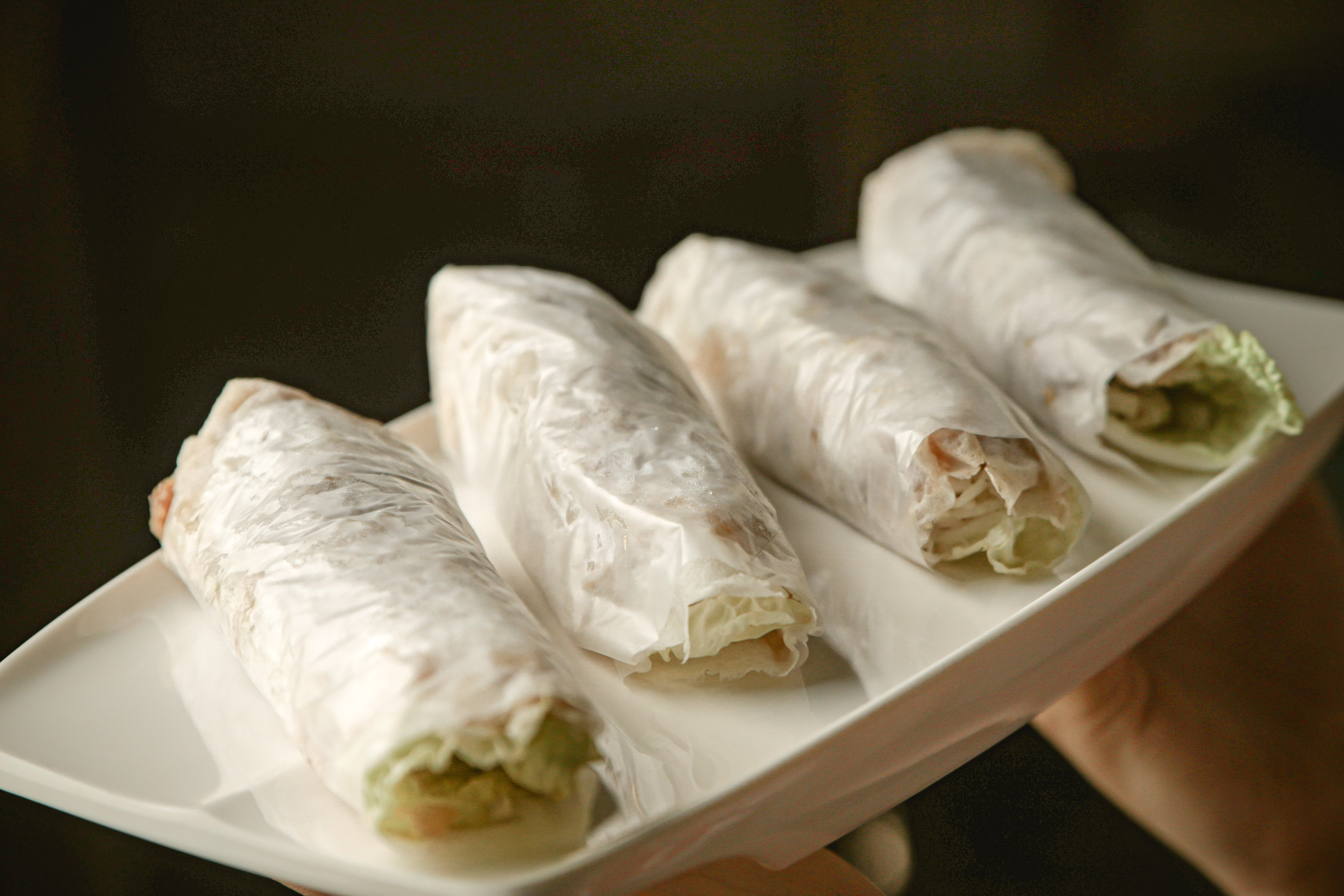
Fresh lumpia “ubod” is a favorite Negrense merienda.
Popular Lumpia Ubod Versions: Can You Tell The Difference?
A Google search of "fresh lumpia" retrieves photos of a raw burrito-sized crepe slathered with a brown nut-studded sauce, the kind you’d need to tackle with a fork. It’s only when you add "Negrense" to refine your search that the local spring roll appears – pale sans the sauce, a sprig of leaf jutting out, and small enough to hold with one hand. This is the fresh lumpia ubod that Negrenses are familiar with, the kind hawked in buses and market sidewalks, or conveniently grabbed from homegrown eateries, or as prized snack specialties sought in fabled kitchens.
The Negros Season of Culture invited Chef Richard Ynayan, Director of the Institute of Culinary Arts De La Salle, to offer an opinion on five of the most cherished fresh lumpia ubod versions in Negros. Himself a fresh lumpia lover, Chef Ynayan describes the Negrense take on this delicate merienda staple: the main filling is ubod, or heart of palm, julienned and sauteed in garlic and onion, then swirled in a slurry of cornstarch, brown sugar, and water, and finally wrapped in an ultra-thin but sturdy crêpe. A lettuce leaf, Chinese cabbage, or scallion stem may be inserted for extra crunch.
Lumpia Number 1. Light but surprisingly good
Chef Ynayan tries this lumpia version first. Lighter in color and a little thicker than the rest, this fresh lumpia is typically peddled in bus stations. With one bite, this French culinary school and New York trained chef opines. "In fairness, namit sya (it is delicious)…in fairness ha!"
Chef Ynayan observes that while this lumpia from the south of Negros may appear simple, he commends the light characteristic sweetness of the ubod filling. "It works well… some people would like it, especially the old ones looking for healthier alternatives," the chef adds. "Pasado gid! (It passes the test!)”
How do you like your Fresh lumpia “ubod”?
Lumpia Number 2: Hometown Classic
The second lumpia version, Chef Ynayan knows too well. The special ingredient? Chicharron.
"I always ask for extra chicharron whenever I have this," Chef Ynayan shares. He likes to liberally dress the fresh lumpia with crushed chicharron, bite after bite.
The cracklings, Chinese cabbage, and bits of pork give the lumpia a savory interplay of texture, and his advice is to consume this well within three hours after it’s made, before the chicharron loses its crunch. These classics are usually sold at public markets, alongside other native delicacies arranged in cheesecloth-covered native winnowing trays.
Chef Ynayan declares, "This one, I can eat forever and ever!"
Chef Richard Ynayan of ICA De La Salle tries five Negrense fresh lumpia “ubod” versions.
Lumpia Number 3: Signature and Stand-alone
Chef Ynayan approaches Lumpia Number 3 with such reverence, commenting on its fine form. “I’m sure there is only one person who wraps it." The chef believes that a lithe hand is a big factor behind the consistency of each of this version’s roll. “See that kind of elegance,” he gushes over a piece, “daw mahuya ka kiharon (you’d be ashamed to slice it).”
This lumpia version also has a distinct flavor that is not found in others, Chef Ynayan points out. “It’s garlicky, and it has a certain spice that gives it a minty taste all its own.” The Chef adds, “The garlic is very alive,” then goes on to make an analogy, “kung bampira ka, indi gid ni puede sa imo (if you’re a vampire, this is definitely not for you).”
Priced at a premium, Chef Ynayan calls this the Gucci of fresh lumpia ubod.
A seasoned market vendor in Silay assembles a batch of fresh lumpia “ubod”.
Lumpia Number 4: Chicharron-happy
Chef Ynayan notes that this version also has chicharron as its potent ingredient – not just a dusting, mind you, but with chunks of crunchy pork rind. Examining a piece, the chef observes how the chicharron bits generously dot the ubod filling as seen through the translucent crêpe.
But what makes Lumbia Number 4 special to Chef Ynayan is the nostalgia it brings. “My brothers and I would fight over this.” Sinking his teeth into the soft roll transports Chef Ynayan to his younger years when the store where this lumpia variety was served was located just outside his school campus.
The taste is still the same as the old days, the wistful chef confirms. “True enough, (Lumpia Number 4) does not disappoint.”
Lumpia Number 5: Savory, less sugary option
The fifth version, another Negrense go-to for generations now, is a slight departure from the classic fresh lumpia ubod. Chef Ynayan points out that it is more savory than sweet, compared to the minatamis na ubod (sweetened heart of palm) that the other four varieties prefer. Another interesting feature of Lumpia Number 5 is that it has mashed hard-boiled egg incorporated into the filling. The chef warns though not to delay eating this since the egg shortens all the more the already tricky shelf life of the fresh lumpia ubod.
This unique lumpia version is served at a well-loved pit stop before the airport, so it is conveniently available. Thus, Chef Ynayan shares, “If I miss fresh lumpia ubod, this would be my filler.” He then concludes that with this lumpia version, “Cravings satisfied!”
How good is your lumpia-o-meter?
If you are truly a Negrense lumpia monster like Chef Ynayan, could you guess our five mystery versions?
Lumpia Number 1 is made by the Custodio family from San Enrique, a town in the southern part of Negros Occidental; Lumpia Number 2 is the classic fresh lumpia ubod of Silay by Sinda Belleza; Lumpia Number 3 is from Emma Lacson; Lumpia Number 4 is Yummy-yummy’s; Lumpia Number 5 is El Ideal’s.
Now, it’s your turn to buy and sample all five and exclaim, “cravings satisfied”!
Text By: Kimmee Santiago
Photos by: Unit A Creatives
Popular Lumpia Ubod Versions: Can You Tell The Difference?
by
Negros Season of Culture •
Thursday, November 03, 2022
Design and Architecture
Cultural Experience
Art and Craft
Food
People
BAO
-

Negros Season of Culture

Rooted. Taking on the World.
A global messaging system that promotes the cultural assets of Negros as shaped by its rich heritage and traditions, the unique identity of the place, and the talent of its people.
Popular Posts
O Senyor, Tagbalay
Saturday, December 18, 2021

From City Grind to Local Craft: The Story of IWOODlike Bacolod
Wednesday, December 10, 2025

Dinagsa Festival
Sunday, January 07, 2024
Rooted. Taking on the World.
Negros Season of Culture is a global messaging system that promotes the cultural assets of Negros as shaped by its rich heritage and traditions, the unique identity of the place, and the talent of its people.
Search This Site
Quick Links
People
Design and Architecture
Upcoming Events
Art and Craft
BAO
Food
Menu Footer Widget
Rooted. Taking on the World.
A global messaging system that promotes the cultural assets of Negros as shaped by its rich heritage and traditions, the unique identity of the place, and the talent of its people.
Search This Site
Upcoming Events
 Negros Season of Culture Celebrates National Heritage Month
Negros Season of Culture Celebrates National Heritage Month
The Negros Season of Culture Celebrates National Heritage Month this... Negros Season of Culture joins the National Commission on Culture and the Arts in celebrating National Heritage Month
Negros Season of Culture joins the National Commission on Culture and the Arts in celebrating National Heritage Month
Negros Season of Culture joins the National Commission on Culture...
Menu Footer Widget
• Copyright © -2021
- Negros Season of Culture



